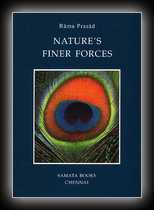
Nature's Finer Forces: The Science of Breath and the Philosophy of the Tattvas
by Rama Prasad, M.A., F.T.S.
1894
PREFACE.
A WORD of explanation is necessary with regard to the book now offered to the public. In the ninth and tenth volumes of The Theosophist I wrote certain essays on "Nature's Finer Forces." The subject of these essays interested the readers of TJie Thcosophist so much, that I was asked to issue the series of essays in book form. On reading the essays for this purpose I found that in order to make a book they must be almost entirely rearranged and perhaps re-written. However, not being equal to the task of re-writing what I had once written, I determined to publish a translation of the book in Sanskrit on the Science of Breath and the Philosophy of the Tattvas. As, more over, without these essays the book would have been quite unintelligible, I decided to add them to the book by way of an illustrative introduction. This accord ingly has been done. The essays in The Theosophist have been reprinted with certain additions, modifications and corrections. Besides, I have written several more essays in order to make the explanations more complete and authoritative.
I was confirmed in this course by one more consideration. The book contains a good deal more than the essays touched upon, and I thought it better to lay all of it before the public.
The book is sure to throw a good deal of light upon the scientific researches of the ancient Aryans of India, and it will leave no doubt in a candid mind that the religion of ancient India had a scientific basis. It is chiefly for this reason that I have drawn my illustrations of the Tattvic Law from the Upanishads.
There is a good deal in the book which can only be shown to be true by long and diligent experiment. Those who are devoted to the pursuit of truth with out prejudice will no doubt be ready to wait before they form any opinion about such portions of the book. Others it is useless to reason with.
To the former class of students I have to say one word more. From my own experience I can tell them that the more they study the book, the more wisdom they are sure to find in it, and let me hope that ere long I shall have a goodly number of colleagues, who will with me try their best to explain and illustrate the book still better and more thoroughly. MEERUT, INDIA, RAMA PRASAD.
November 5th 1889.
PREFACE TO THE SECOND AND REVISED EDITION.
THE points on which revision has been attempted are: (i) the style of printing has been made uniform with the rest of the books printed on the "H. P. B." Press; (2) consistency in transliteration of Sanskrit terms has been studied, and a number of errors cor rected; (3) the English of some phrases has been improved; and (4) a few passages have been omitted from the text. R. H. is responsible for some small portion of the work of revision, and for the rest the undersigned, who has a high appreciation of Mr. Rama Prasad's essays—an appreciation, however, which is not extended to certain portions of the Tantrik work he has so ably translated.
G. R. S. M. LONDON, 1894.
NATURE'S FINER FORCES,
AND THF.IR INFLUENCE UPON
HUMAN LIFE AND DESTINY.
i.
THE TATTVAS.
THE Tattvas are the five modifications of the Great Breath. Acting upon Prakriti this Great Breath throws it into five states, having distinctive vibratory motions, and performing different functions. The first outcome of the evolutionary state of Parabrah-man is the Akasha Tattva. After this come in order the Vayu, the Tejas, the Apas and the Prithivi. They are variously known as Mahabhiitas. The word Akasha is generally translated into English by the word ether. Unfortunately, however, to modern Eng lish science sound is not known to be the distinguish ing quality of ether. Some few might also have the idea that the modern medium of light is the same as Akasha. 'This, I believe, is a mistake. The lumini-ferous ether is the subtle Tejas Tattva, and not the Akasha. All the five subtle Tattvas might no doubt be called ethers, but to use the term ether for Akasha.
